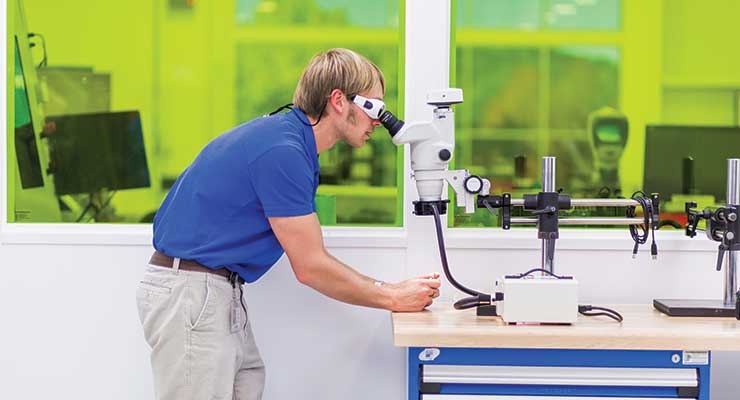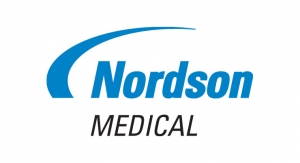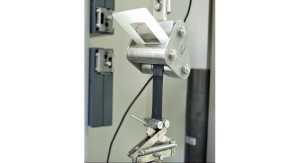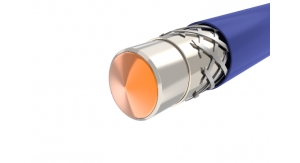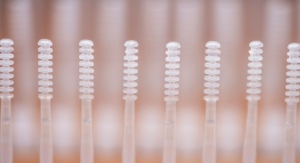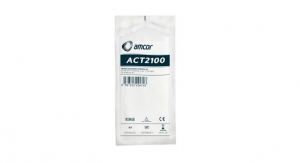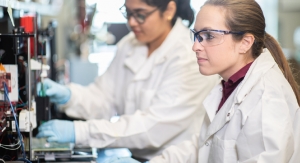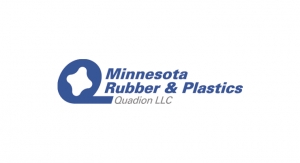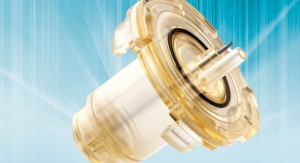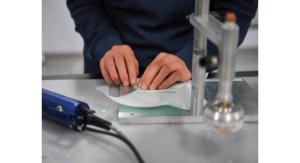Sam Brusco, Associate Editor03.07.17
Quick—name the allotrope of carbon that takes the form of a two-dimensional, atomic scale, hexagonal lattice in which one atom forms each vertex.
Not ringing any bells? Perhaps another hint, then. This material is widely regarded to have enormous potential in medicine, with possible applications including bone implants, non-invasive blood sugar monitoring, painless drug delivery, and MRI contrast agents that target specific tissues, among many others. Its three-dimensional form is commonly found in pencils, and it can be “manufactured” by drawing on a piece of paper and removing the writing layer by layer with a piece of scotch tape.
Figured it out yet? Why, it’s graphene, of course!
The funny thing is graphene has unintentionally been produced in small amounts for centuries, using pencils or other graphite applications. Originally spotted in electron microscopes in 1962, it was later rediscovered, isolated, and characterized in 2004. However, the discovery was also anything but intentional. One Friday, Andre Geim and Konstantin Novoselov, two University of Manchester scientists, removed some flakes from a chunk of graphite with sticky tape. They realized that some of the flakes were thinner than others, and by repeat separations were able to create flakes one atom thick. (It is because of this one-atom thickness that graphene is widely considered to be “two-dimensional.”)
Since its discovery, graphene has revealed some truly astonishing material properties. It is incredibly light but immensely tough—200 times stronger than steel, according to the University of Manchester. Despite this robust nature, however, graphene remains quite flexible. It is also an excellent conductor and provides a perfect barrier; not even helium can pass through it. These properties make graphene a promising candidate for next-generation wearable biomedical sensors that are both flexible and highly conductive.
Researchers have been experimenting with graphene for a number of biomedical applications. University of Illinois at Chicago scientists recently interfaced brain cells onto graphene, showing that a single hyperactive cancerous cell could be differentiated from a normal cell. Researchers from AMBER, the Science Foundation Ireland-funded materials science research center, combined graphene with silly putty (“G-putty”) to create a sensor extremely responsive to strain and pressure. The G-putty was mounted onto the chest and neck of human subjects and was able to measure breathing, pulse, and even blood pressure.
As astonishing and promising as graphene is in medicine, however, it will undoubtedly face a slow migration into medical device technologies. Incorporating any new material is a costly and timely effort, requiring new research, clinical trialing, and regulatory approvals. Following all that, a method to manufacture graphene in an affordable way would be necessary, and even that might not be the catalyst to wider adoption. For these reasons (among others), in selecting materials to manufacture medical devices, it seems some medical device OEMs are slow to move from what has always worked.
“Most OEMs have materials that have been specified in their material database for years—unless there is a specific need to go outside that database for a material that has a specific requirement,” explained Tim Reis, vice president of healthcare business development for Bethel, Vt.-based GW Plastics. “We see a lot of commonality with traditional engineering grade material—ABS, polycarbonate, nylon, polyesters, in addition to the high-performance grades. This recurrence is driven primarily by the cost of bringing a new material on board. Factors like biocompatibility, testing, and the overall approval process make OEMs typically stay within their wheelhouse unless there is a specific need otherwise.”
“We’re seeing requests for the same general classes of silicone materials that have been on the market for years,” noted James Lambert, Ph.D., director of R&D for biomaterials for Center Valley, Pa.-based Avantor Performance Materials LLC. However, even though OEMs are requesting materials in their comfort zone, they’re interested in modifying them to fit a specific need. So while traditional materials prove to be a safe investment in a project, OEMs are seeking out those with tunable properties. That way, they can be customized to fit a particular end-use.
“OEMs are also requesting more finely tuned properties, or properties that are superior to standard products of the past,” continued Lambert. “We’re noticing increased demand for customized materials with properties tuned specifically to the end-use application, supported with deep technical knowledge and regulatory expertise. For silicones, this includes: predictable elastomer cure rate profiles for extrusion or molding applications so OEMs can run more efficiently, targeted stress/strain behavior of elastomers utilized in devices with demanding end-use performance (such as in drug delivery devices), adhesive technologies for difficult-to-bond dissimilar surfaces, and products with exceptionally low extractables and leachables and well-documented chemistry profiles.”
Taking a Peek at PEEK
In order to illustrate the journey a new material must make into device technologies, the organic polymer thermoplastic Polyetheretherketone (colloquially known as PEEK) is becoming quite famous. However, PEEK took some time to reach its celebrity status. PEEK use began in the 1980s with experimental medical devices, and underwent a number of clinical studies in the 1990s that led it to widespread clinical acceptance. PEEK-OPTIMA (the first implantable unfilled PEEK polymer) was engineered in 1999, establishing it as a biomaterial for implantable applications.
“We typically see PEEK or Biocomposite for the implant work,” described Ryan Aleshevich, business development manager at Cadence Inc.’s Staunton, Va. facility. “PEEK is pretty much the standard for implants these days.”
Implantable PEEK polymers have become available in a variety of formulations, from unfilled grades with differing molecular weights, to image-contrast and carbon fiber-reinforced grades. Known for impressive wear and abrasion resistance as well as a low coefficient of friction, it has found a great deal of success in orthopedic implants in particular. However, this “new” material (which sounds so odd to say because it’s been clinically viable for about two decades now) comes with its own set of challenges.
“PEEK is a commonly requested material for micro-medical components,” commented Peter Wojtas, a senior process engineer for Charlton, Mass.-based MTD Micro Molding. “But PEEK presents many challenges in advanced micro-molding, which can make this material choice an expensive proposition. We encourage our customers to fully evaluate exactly what is needed from their material to meet their product requirements, because we find that PEEK can be ‘overqualified’ for many applications.”
“Although successful micro-molding with PEEK is possible and yields a more homogeneous product than machining, the medical grade PEEK required for injection molding is very expensive as compared to the formed rods and sheets commonly used in machining,” added Gary Hulecki, executive vice president of MTD. “Also, high melt temperature and mold temperature make for extremely difficult processing conditions.”
What Hulecki described seems to be the main issue with innovative materials like PEEK. There’s a lot of opportunity in using the material, but an efficient and cost-effective method to produce it lags behind. After nearly three decades of research on PEEK, manufacturers and molding providers alike are still finding issues in manufacturing it in a cost-effective way. Further, jumping on the bandwagon of a newer material like PEEK may not be necessary for any given device.
“Most applications don’t require the chemical resistance and crystalline properties that PEEK is known for providing,” commented Dennis Tully, MTD’s president.
Smarter Devices, Smarter Materials
A “wonder material” like graphene could take a decade (or more) before becoming a part of commercially available medical products. That’s not to say the graphene hype isn’t deserved—the material could be quite a boon for a number of sectors—but in the medical device industry, there’s no use mooning over a material that can’t be practically processed. So is that to say finding new materials or new applications for existing materials is too risky to attempt?
In a healthcare environment moving inexorably toward personalized solutions, absolutely not. In fact, some feel it will be necessary to work with new materials or expand the application areas of traditional materials. One example of this is the trend of wearable technologies with longer wear times. Wearable devices seek the goal of continuous, and sometimes remote monitoring, so their materials must not cause irritation with their contact area and hold up to everyday body motion.
“One to two years ago, the target was usually a seven-day wear time but the bar is being raised to 14-day, 21-day, or longer wear time,” pointed out Neal Carty, Ph.D., director of R&D, as well as medical and scientific affairs for Chicago, Ill.-based Vancive Medical Technologies. “Long-term wear is important for patient comfort and convenience, and it also relates to device cost. Electronic modules are expensive, and so you want wearable devices, especially disposable ones, to stay on the skin as long as possible. Emerging applications include diabetes care, such as materials used in continuous glucose monitors and wearable insulin pumps, cardiac telemetry, basic activity monitors (i.e., devices for tracking steps, calories burned, etc.), and many more. Longer wear time presents challenges because the body is such a dynamic system. There is lots of movement, skin cells are continually changing over and dying, and there’s sweat, sebum, etc. These issues get exacerbated over longer and longer wear times. Adhesive systems specifically engineered to enable long-term wear will increasingly emerge as solutions.”
Carty continued, “Engineering a long-term wear solution requires the right adhesive chemistry to achieve proper adhesion, plus long-term biocompatibility (no irritation). However, there is a lot more to it. There is no such thing as a ‘long-term wear adhesive,’ per se. It’s a more complicated problem that is solved by applying material science and biomedical and mechanical engineering in close cooperation with one another. For example, it’s crucial to select appropriate backing materials. Tie layer materials must create a secure bond between the wearable device and the skin-contacting adhesive system, and ideally, they should be breathable for optimal comfort. There is also an extremely important design component. The shape/size of the device and its adhesive system must be engineered to specific use cases. Where will the device be placed on the body? What type of patient will wear it? What is the device’s sensitivity level? All of these considerations are very important and require a multifaceted approach to materials selection and device development.”
“The device industry is going through a change towards more powered and intelligent devices,” said Reis. “Years ago, it was all mechanical devices that required strength as a key property, now dielectric properties and the ability to shield onboard computers are being required.”
Similar to production methods necessarily evolving for new materials to become viable, substantial material innovation must also occur alongside development of next-generation technologies. If OEMs wish to include electronics in their devices, for example, materials that best interact with them must be carefully considered. In some cases, this means modifying or even swapping out a traditionally used material.
“As they replace traditional mechanical surgical devices, the advent of intelligent powered surgical devices will increase usage of new applications for existing materials,” Reis continued. “Metal to plastic replacement will have to go farther than it has traditionally to help the continued drive for cost reduction. This will stretch the resins to perform at higher levels than in the past, possibly driving even new material applications to fill any performance shortcomings.”
In short, smart devices require smart materials. By definition, smart materials are able to be significantly altered in a controlled way via heat, pH changes, stress, moisture, or electric and magnetic fields. Nitinol, a nickel-titanium alloy that has come to the forefront in recent years, is one such class of smart materials. Its intelligence arises from its unique capacity to retain “shape memory.” This means that Nitinol can deform at one temperature, then resume its original shape at a heat above that conversion temperature. Further, Nitinol demonstrates superelastic properties at a small range just above its transformation temperature. No heating is then required to resume its undeformed shape, and it demonstrates 10 to 30 times the elasticity of typical metal.
“We’re not noticing many new materials in use other than Nitinol, which seems to be the ‘hot’ item due to its shape setting/memory capability,” noted Aleshevich. Scott Scheeser, project manager at Cadence’s finished device facility in Pittsburgh, Pa., agreed with Aleshevich, saying, “Nitinol seems to be coming up a lot—especially with tools that are used in laparoscopic procedures.”
Bioabsorbable materials (also called bioresorbable, resorbable, or biodegradable) are also becoming popular—particularly, for many implantable applications—because these materials dissolve or absorb into the body, removing the need for repeat surgeries and reducing concerns regarding adverse effects. Technologies manufactured using this class of materials metabolize over time, eliminating secondary invasive procedures. Some companies offer bioabsorbable material capabilities due to the benefits, even if they’re not a large part of overall business.
“We have had an on-again off-again history with these materials—we have seen it used in tissue and bone screws, anchors, ligating clips, and re-sectioning devices,” explained Reis. “It has not been consistent business, but we do have significant experience in the processing and handling of these materials.”
One quite prominent commercial example of a bioabsorbable material was Abbott Laboratories’ launch of the Absorb bioabsorbable heart stent in July 2016. It is currently the only fully dissolving stent approved to treat coronary artery disease, a leading cause of death worldwide. Stents are traditionally made of metal, but the Absorb stent is composed of a naturally dissolving material that disappears completely in three years—save for two pairs of tiny metallic markers that remain in the artery to enable a physician to see where the device was placed.
“No metal means the treated artery can pulse and flex naturally as demands on the heart change with everyday activities,” Gregg W. Stone, M.D., FACC, FSCAI, director, cardiovascular research and education, Center for Interventional Vascular Therapy, Columbia University Medical Center, New York-Presbyterian Hospital and the chairman of the ABSORB clinical trial program commented in a press release detailing Absorb’s launch. “No metal may also reduce the potential of future blockages that occur with permanent metallic stents, and allows easier access to other treatment options should they prove necessary in the patient’s future.”
Because they drastically reduce the potential for complications following implantation, bioabsorbable materials are becoming a hot-ticket item for certain types of medical devices. It seems rather unlikely that Absorb will continue to be the only class of such a device considering bioabsorbable materials’ potential benefits. But as trendy as bioabsorbables are now, they’re not exactly new.
“While bioabsorbables seem like a new trend, MTD has been micro-molding bioabsorbable medical components for 15 years, and has worked with numerous types of bioabsorbable polymers,” the MTD team said. “A successful bioabsorbable micro-molding project will incorporate the criteria of premium part quality from a robust molding process window, less invasive devices with increased precision and capability, superior post-mold mechanical and functional properties, consistent and minimal post-mold IV loss, and highly capable critical dimensions. We help our strategic partners develop new solutions, exploring and producing tiny, delicate, and intricate components required for specialized surgeries, bioabsorbable devices, and implant devices.”
Materials of the Future
Graphene is being hailed as the material of the future for medicine. Its application areas sit firmly in the experimental stages, comparable to where PEEK was in the early 1980s. With continued experimentation comes further understanding about graphene’s material properties, and hopefully its timeline to formal clinical trialing and regulatory approval moves a bit more quickly than PEEK. And, as mentioned before, once a material is recognized as clinically viable and garners all the necessary approvals, it may still face the hurdle of a practical manufacturing method.
Due to this, perhaps those looking to work with or engineer new materials should consider that particular material’s manufacturing strategy. “Current interest in developing materials for 3D printing suggests this could be an area of emerging interest over the next few years,” posited Lambert.
Considering the opportunities and limitations of a manufacturing method before moving full steam ahead with a new material may be an effective strategy. 3D printing materials are an interesting example because recent developments have proven that 3D printers can be made or tuned to handle plastics, metals, and even biological components. Further, since bioabsorbable materials have emerged (again), why not tackle both fronts?
“3D printing is a tool that we are just beginning to understand the potential of, especially as the process becomes faster and safer,” said Scheeser. “I think bioabsorbable materials will continue to grow in the industry, and the potential to print bioabsorbable components could be very interesting.”
In fact, many believe bioabsorbable materials have not yet reached their full potential—the Absorb stent is only the tip of the iceberg for widely adopted commercial applications.
“Bioabsorbable applications will continue to grow with wider exposure and acceptance in marketplace,” predicted Brian Matachun, director of technical sales at MTD. “As exposure and interest continues to grow, novel and improved uses will follow suit. Bioabsorbables have also become popular for products in the closure market and laparoscopic procedures. With the advent of new materials and engineers pioneering new solutions, the products have expanded into dynamic devices. The materials now need to bend and flex like an elastomer but provide high mechanical strengths to achieve the desired result.”
“Personal patient care advancements will be enabled by precision delivery components, which are made possible by high aspect ratio micro-molding technology,” prognosticated Hulecki. “Micro-molding will also continue to be a solution for polymer-based drug delivery systems. Traditional molding practices would not allow a drug to be compounded into a material before molding, without severely degrading it through the injection molding process. But with specialized medical micro-molding it is, in fact, very possible. Products like drug-eluting bioabsorbable implants are becoming more prevalent in the market. These products consist of an active drug that is compounded with a bioabsorbable material that gets injection molded and then implanted inside the body. The bioabsorbable carrier dissolves, delivering the drug into the surrounding tissue over a controlled period of time.”
The main message to be gained is that OEMs want their materials to be as flexible as the devices they’ll compose. Whether this means engineering new materials, tuning existing materials, or discovering new application areas for traditional materials remains to be seen.
“What we predict it all coming down to is material that has enhanced performance requirements and qualities,” asserted Reis. This includes strength, lubricants, shielding properties, enhanced flow, and increased dimensional stability. That is where we see the market going over the next few years.”
Not ringing any bells? Perhaps another hint, then. This material is widely regarded to have enormous potential in medicine, with possible applications including bone implants, non-invasive blood sugar monitoring, painless drug delivery, and MRI contrast agents that target specific tissues, among many others. Its three-dimensional form is commonly found in pencils, and it can be “manufactured” by drawing on a piece of paper and removing the writing layer by layer with a piece of scotch tape.
Figured it out yet? Why, it’s graphene, of course!
The funny thing is graphene has unintentionally been produced in small amounts for centuries, using pencils or other graphite applications. Originally spotted in electron microscopes in 1962, it was later rediscovered, isolated, and characterized in 2004. However, the discovery was also anything but intentional. One Friday, Andre Geim and Konstantin Novoselov, two University of Manchester scientists, removed some flakes from a chunk of graphite with sticky tape. They realized that some of the flakes were thinner than others, and by repeat separations were able to create flakes one atom thick. (It is because of this one-atom thickness that graphene is widely considered to be “two-dimensional.”)
Since its discovery, graphene has revealed some truly astonishing material properties. It is incredibly light but immensely tough—200 times stronger than steel, according to the University of Manchester. Despite this robust nature, however, graphene remains quite flexible. It is also an excellent conductor and provides a perfect barrier; not even helium can pass through it. These properties make graphene a promising candidate for next-generation wearable biomedical sensors that are both flexible and highly conductive.
Researchers have been experimenting with graphene for a number of biomedical applications. University of Illinois at Chicago scientists recently interfaced brain cells onto graphene, showing that a single hyperactive cancerous cell could be differentiated from a normal cell. Researchers from AMBER, the Science Foundation Ireland-funded materials science research center, combined graphene with silly putty (“G-putty”) to create a sensor extremely responsive to strain and pressure. The G-putty was mounted onto the chest and neck of human subjects and was able to measure breathing, pulse, and even blood pressure.
As astonishing and promising as graphene is in medicine, however, it will undoubtedly face a slow migration into medical device technologies. Incorporating any new material is a costly and timely effort, requiring new research, clinical trialing, and regulatory approvals. Following all that, a method to manufacture graphene in an affordable way would be necessary, and even that might not be the catalyst to wider adoption. For these reasons (among others), in selecting materials to manufacture medical devices, it seems some medical device OEMs are slow to move from what has always worked.
“Most OEMs have materials that have been specified in their material database for years—unless there is a specific need to go outside that database for a material that has a specific requirement,” explained Tim Reis, vice president of healthcare business development for Bethel, Vt.-based GW Plastics. “We see a lot of commonality with traditional engineering grade material—ABS, polycarbonate, nylon, polyesters, in addition to the high-performance grades. This recurrence is driven primarily by the cost of bringing a new material on board. Factors like biocompatibility, testing, and the overall approval process make OEMs typically stay within their wheelhouse unless there is a specific need otherwise.”
“We’re seeing requests for the same general classes of silicone materials that have been on the market for years,” noted James Lambert, Ph.D., director of R&D for biomaterials for Center Valley, Pa.-based Avantor Performance Materials LLC. However, even though OEMs are requesting materials in their comfort zone, they’re interested in modifying them to fit a specific need. So while traditional materials prove to be a safe investment in a project, OEMs are seeking out those with tunable properties. That way, they can be customized to fit a particular end-use.
“OEMs are also requesting more finely tuned properties, or properties that are superior to standard products of the past,” continued Lambert. “We’re noticing increased demand for customized materials with properties tuned specifically to the end-use application, supported with deep technical knowledge and regulatory expertise. For silicones, this includes: predictable elastomer cure rate profiles for extrusion or molding applications so OEMs can run more efficiently, targeted stress/strain behavior of elastomers utilized in devices with demanding end-use performance (such as in drug delivery devices), adhesive technologies for difficult-to-bond dissimilar surfaces, and products with exceptionally low extractables and leachables and well-documented chemistry profiles.”
Taking a Peek at PEEK
In order to illustrate the journey a new material must make into device technologies, the organic polymer thermoplastic Polyetheretherketone (colloquially known as PEEK) is becoming quite famous. However, PEEK took some time to reach its celebrity status. PEEK use began in the 1980s with experimental medical devices, and underwent a number of clinical studies in the 1990s that led it to widespread clinical acceptance. PEEK-OPTIMA (the first implantable unfilled PEEK polymer) was engineered in 1999, establishing it as a biomaterial for implantable applications.
“We typically see PEEK or Biocomposite for the implant work,” described Ryan Aleshevich, business development manager at Cadence Inc.’s Staunton, Va. facility. “PEEK is pretty much the standard for implants these days.”
Implantable PEEK polymers have become available in a variety of formulations, from unfilled grades with differing molecular weights, to image-contrast and carbon fiber-reinforced grades. Known for impressive wear and abrasion resistance as well as a low coefficient of friction, it has found a great deal of success in orthopedic implants in particular. However, this “new” material (which sounds so odd to say because it’s been clinically viable for about two decades now) comes with its own set of challenges.
“PEEK is a commonly requested material for micro-medical components,” commented Peter Wojtas, a senior process engineer for Charlton, Mass.-based MTD Micro Molding. “But PEEK presents many challenges in advanced micro-molding, which can make this material choice an expensive proposition. We encourage our customers to fully evaluate exactly what is needed from their material to meet their product requirements, because we find that PEEK can be ‘overqualified’ for many applications.”
“Although successful micro-molding with PEEK is possible and yields a more homogeneous product than machining, the medical grade PEEK required for injection molding is very expensive as compared to the formed rods and sheets commonly used in machining,” added Gary Hulecki, executive vice president of MTD. “Also, high melt temperature and mold temperature make for extremely difficult processing conditions.”
What Hulecki described seems to be the main issue with innovative materials like PEEK. There’s a lot of opportunity in using the material, but an efficient and cost-effective method to produce it lags behind. After nearly three decades of research on PEEK, manufacturers and molding providers alike are still finding issues in manufacturing it in a cost-effective way. Further, jumping on the bandwagon of a newer material like PEEK may not be necessary for any given device.
“Most applications don’t require the chemical resistance and crystalline properties that PEEK is known for providing,” commented Dennis Tully, MTD’s president.
Smarter Devices, Smarter Materials
A “wonder material” like graphene could take a decade (or more) before becoming a part of commercially available medical products. That’s not to say the graphene hype isn’t deserved—the material could be quite a boon for a number of sectors—but in the medical device industry, there’s no use mooning over a material that can’t be practically processed. So is that to say finding new materials or new applications for existing materials is too risky to attempt?
In a healthcare environment moving inexorably toward personalized solutions, absolutely not. In fact, some feel it will be necessary to work with new materials or expand the application areas of traditional materials. One example of this is the trend of wearable technologies with longer wear times. Wearable devices seek the goal of continuous, and sometimes remote monitoring, so their materials must not cause irritation with their contact area and hold up to everyday body motion.
“One to two years ago, the target was usually a seven-day wear time but the bar is being raised to 14-day, 21-day, or longer wear time,” pointed out Neal Carty, Ph.D., director of R&D, as well as medical and scientific affairs for Chicago, Ill.-based Vancive Medical Technologies. “Long-term wear is important for patient comfort and convenience, and it also relates to device cost. Electronic modules are expensive, and so you want wearable devices, especially disposable ones, to stay on the skin as long as possible. Emerging applications include diabetes care, such as materials used in continuous glucose monitors and wearable insulin pumps, cardiac telemetry, basic activity monitors (i.e., devices for tracking steps, calories burned, etc.), and many more. Longer wear time presents challenges because the body is such a dynamic system. There is lots of movement, skin cells are continually changing over and dying, and there’s sweat, sebum, etc. These issues get exacerbated over longer and longer wear times. Adhesive systems specifically engineered to enable long-term wear will increasingly emerge as solutions.”
Carty continued, “Engineering a long-term wear solution requires the right adhesive chemistry to achieve proper adhesion, plus long-term biocompatibility (no irritation). However, there is a lot more to it. There is no such thing as a ‘long-term wear adhesive,’ per se. It’s a more complicated problem that is solved by applying material science and biomedical and mechanical engineering in close cooperation with one another. For example, it’s crucial to select appropriate backing materials. Tie layer materials must create a secure bond between the wearable device and the skin-contacting adhesive system, and ideally, they should be breathable for optimal comfort. There is also an extremely important design component. The shape/size of the device and its adhesive system must be engineered to specific use cases. Where will the device be placed on the body? What type of patient will wear it? What is the device’s sensitivity level? All of these considerations are very important and require a multifaceted approach to materials selection and device development.”
“The device industry is going through a change towards more powered and intelligent devices,” said Reis. “Years ago, it was all mechanical devices that required strength as a key property, now dielectric properties and the ability to shield onboard computers are being required.”
Similar to production methods necessarily evolving for new materials to become viable, substantial material innovation must also occur alongside development of next-generation technologies. If OEMs wish to include electronics in their devices, for example, materials that best interact with them must be carefully considered. In some cases, this means modifying or even swapping out a traditionally used material.
“As they replace traditional mechanical surgical devices, the advent of intelligent powered surgical devices will increase usage of new applications for existing materials,” Reis continued. “Metal to plastic replacement will have to go farther than it has traditionally to help the continued drive for cost reduction. This will stretch the resins to perform at higher levels than in the past, possibly driving even new material applications to fill any performance shortcomings.”
In short, smart devices require smart materials. By definition, smart materials are able to be significantly altered in a controlled way via heat, pH changes, stress, moisture, or electric and magnetic fields. Nitinol, a nickel-titanium alloy that has come to the forefront in recent years, is one such class of smart materials. Its intelligence arises from its unique capacity to retain “shape memory.” This means that Nitinol can deform at one temperature, then resume its original shape at a heat above that conversion temperature. Further, Nitinol demonstrates superelastic properties at a small range just above its transformation temperature. No heating is then required to resume its undeformed shape, and it demonstrates 10 to 30 times the elasticity of typical metal.
“We’re not noticing many new materials in use other than Nitinol, which seems to be the ‘hot’ item due to its shape setting/memory capability,” noted Aleshevich. Scott Scheeser, project manager at Cadence’s finished device facility in Pittsburgh, Pa., agreed with Aleshevich, saying, “Nitinol seems to be coming up a lot—especially with tools that are used in laparoscopic procedures.”
Bioabsorbable materials (also called bioresorbable, resorbable, or biodegradable) are also becoming popular—particularly, for many implantable applications—because these materials dissolve or absorb into the body, removing the need for repeat surgeries and reducing concerns regarding adverse effects. Technologies manufactured using this class of materials metabolize over time, eliminating secondary invasive procedures. Some companies offer bioabsorbable material capabilities due to the benefits, even if they’re not a large part of overall business.
“We have had an on-again off-again history with these materials—we have seen it used in tissue and bone screws, anchors, ligating clips, and re-sectioning devices,” explained Reis. “It has not been consistent business, but we do have significant experience in the processing and handling of these materials.”
One quite prominent commercial example of a bioabsorbable material was Abbott Laboratories’ launch of the Absorb bioabsorbable heart stent in July 2016. It is currently the only fully dissolving stent approved to treat coronary artery disease, a leading cause of death worldwide. Stents are traditionally made of metal, but the Absorb stent is composed of a naturally dissolving material that disappears completely in three years—save for two pairs of tiny metallic markers that remain in the artery to enable a physician to see where the device was placed.
“No metal means the treated artery can pulse and flex naturally as demands on the heart change with everyday activities,” Gregg W. Stone, M.D., FACC, FSCAI, director, cardiovascular research and education, Center for Interventional Vascular Therapy, Columbia University Medical Center, New York-Presbyterian Hospital and the chairman of the ABSORB clinical trial program commented in a press release detailing Absorb’s launch. “No metal may also reduce the potential of future blockages that occur with permanent metallic stents, and allows easier access to other treatment options should they prove necessary in the patient’s future.”
Because they drastically reduce the potential for complications following implantation, bioabsorbable materials are becoming a hot-ticket item for certain types of medical devices. It seems rather unlikely that Absorb will continue to be the only class of such a device considering bioabsorbable materials’ potential benefits. But as trendy as bioabsorbables are now, they’re not exactly new.
“While bioabsorbables seem like a new trend, MTD has been micro-molding bioabsorbable medical components for 15 years, and has worked with numerous types of bioabsorbable polymers,” the MTD team said. “A successful bioabsorbable micro-molding project will incorporate the criteria of premium part quality from a robust molding process window, less invasive devices with increased precision and capability, superior post-mold mechanical and functional properties, consistent and minimal post-mold IV loss, and highly capable critical dimensions. We help our strategic partners develop new solutions, exploring and producing tiny, delicate, and intricate components required for specialized surgeries, bioabsorbable devices, and implant devices.”
Materials of the Future
Graphene is being hailed as the material of the future for medicine. Its application areas sit firmly in the experimental stages, comparable to where PEEK was in the early 1980s. With continued experimentation comes further understanding about graphene’s material properties, and hopefully its timeline to formal clinical trialing and regulatory approval moves a bit more quickly than PEEK. And, as mentioned before, once a material is recognized as clinically viable and garners all the necessary approvals, it may still face the hurdle of a practical manufacturing method.
Due to this, perhaps those looking to work with or engineer new materials should consider that particular material’s manufacturing strategy. “Current interest in developing materials for 3D printing suggests this could be an area of emerging interest over the next few years,” posited Lambert.
Considering the opportunities and limitations of a manufacturing method before moving full steam ahead with a new material may be an effective strategy. 3D printing materials are an interesting example because recent developments have proven that 3D printers can be made or tuned to handle plastics, metals, and even biological components. Further, since bioabsorbable materials have emerged (again), why not tackle both fronts?
“3D printing is a tool that we are just beginning to understand the potential of, especially as the process becomes faster and safer,” said Scheeser. “I think bioabsorbable materials will continue to grow in the industry, and the potential to print bioabsorbable components could be very interesting.”
In fact, many believe bioabsorbable materials have not yet reached their full potential—the Absorb stent is only the tip of the iceberg for widely adopted commercial applications.
“Bioabsorbable applications will continue to grow with wider exposure and acceptance in marketplace,” predicted Brian Matachun, director of technical sales at MTD. “As exposure and interest continues to grow, novel and improved uses will follow suit. Bioabsorbables have also become popular for products in the closure market and laparoscopic procedures. With the advent of new materials and engineers pioneering new solutions, the products have expanded into dynamic devices. The materials now need to bend and flex like an elastomer but provide high mechanical strengths to achieve the desired result.”
“Personal patient care advancements will be enabled by precision delivery components, which are made possible by high aspect ratio micro-molding technology,” prognosticated Hulecki. “Micro-molding will also continue to be a solution for polymer-based drug delivery systems. Traditional molding practices would not allow a drug to be compounded into a material before molding, without severely degrading it through the injection molding process. But with specialized medical micro-molding it is, in fact, very possible. Products like drug-eluting bioabsorbable implants are becoming more prevalent in the market. These products consist of an active drug that is compounded with a bioabsorbable material that gets injection molded and then implanted inside the body. The bioabsorbable carrier dissolves, delivering the drug into the surrounding tissue over a controlled period of time.”
The main message to be gained is that OEMs want their materials to be as flexible as the devices they’ll compose. Whether this means engineering new materials, tuning existing materials, or discovering new application areas for traditional materials remains to be seen.
“What we predict it all coming down to is material that has enhanced performance requirements and qualities,” asserted Reis. This includes strength, lubricants, shielding properties, enhanced flow, and increased dimensional stability. That is where we see the market going over the next few years.”

